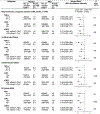Sex Differences in Cardiovascular Outcomes in CKD: Findings From the CRIC Study
- PMID: 33857532
- PMCID: PMC8316276
- DOI: 10.1053/j.ajkd.2021.01.020
Sex Differences in Cardiovascular Outcomes in CKD: Findings From the CRIC Study
Abstract
Rationale & objective: Cardiovascular events are less common in women than men in general populations; however, studies in chronic kidney disease (CKD) are less conclusive. We evaluated sex-related differences in cardiovascular events and death in adults with CKD.
Study design: Prospective cohort study.
Setting & participants: 1,778 women and 2,161 men enrolled in the Chronic Renal Insufficiency Cohort (CRIC).
Exposure: Sex (women vs men).
Outcome: Atherosclerotic composite outcome (myocardial infarction, stroke, or peripheral artery disease), incident heart failure, cardiovascular death, and all-cause death.
Analytical approach: Cox proportional hazards regression.
Results: During a median follow-up period of 9.6 years, we observed 698 atherosclerotic events (women, 264; men, 434), 762 heart failure events (women, 331; men, 431), 435 cardiovascular deaths (women, 163; men, 274), and 1,158 deaths from any cause (women, 449; men, 709). In analyses adjusted for sociodemographic, clinical, and metabolic parameters, women had a lower risk of atherosclerotic events (HR, 0.71 [95% CI, 0.57-0.88]), heart failure (HR, 0.76 [95% CI, 0.62-0.93]), cardiovascular death (HR, 0.55 [95% CI, 0.42-0.72]), and death from any cause (HR, 0.58 [95% CI, 0.49-0.69]) compared with men. These associations remained statistically significant after adjusting for cardiac and inflammation biomarkers.
Limitations: Assessment of sex hormones, which may play a role in cardiovascular risk, was not included.
Conclusions: In a large, diverse cohort of adults with CKD, compared with men, women had lower risks of cardiovascular events, cardiovascular mortality, and mortality from any cause. These differences were not explained by measured cardiovascular risk factors.
Keywords: Atherosclerotic event; cardiac biomarker; cardiovascular disease (CVD); cardiovascular outcomes; chronic kidney disease (CKD); female; heart failure; male; mortality; myocardial infarction (MI); risk assessment; sex differences; sex factors.
Copyright © 2021 National Kidney Foundation, Inc. Published by Elsevier Inc. All rights reserved.
Figures


Comment in
-
Do Sex and Gender Matter in Kidney and Cardiovascular Disease?Am J Kidney Dis. 2021 Aug;78(2):177-179. doi: 10.1053/j.ajkd.2021.05.002. Epub 2021 Jun 11. Am J Kidney Dis. 2021. PMID: 34120781 No abstract available.
Similar articles
-
Self-reported Physical Activity and Cardiovascular Events in Adults With CKD: Findings From the CRIC (Chronic Renal Insufficiency Cohort) Study.Am J Kidney Dis. 2022 Dec;80(6):751-761.e1. doi: 10.1053/j.ajkd.2022.05.007. Epub 2022 Jul 7. Am J Kidney Dis. 2022. PMID: 35810825 Free PMC article.
-
Association Between Kidney Clearance of Secretory Solutes and Cardiovascular Events: The Chronic Renal Insufficiency Cohort (CRIC) Study.Am J Kidney Dis. 2021 Aug;78(2):226-235.e1. doi: 10.1053/j.ajkd.2020.12.005. Epub 2021 Jan 7. Am J Kidney Dis. 2021. PMID: 33421453 Free PMC article.
-
Frailty and Cardiovascular Outcomes in Adults With CKD: Findings From the Chronic Renal Insufficiency Cohort (CRIC) Study.Am J Kidney Dis. 2024 Feb;83(2):208-215. doi: 10.1053/j.ajkd.2023.06.009. Epub 2023 Sep 21. Am J Kidney Dis. 2024. PMID: 37741609 Free PMC article.
-
Myeloperoxidase is Independently Associated with Incident Heart Failure in Patients with Coronary Artery Disease and Kidney Disease.Curr Probl Cardiol. 2022 Nov;47(11):101080. doi: 10.1016/j.cpcardiol.2021.101080. Epub 2021 Dec 12. Curr Probl Cardiol. 2022. PMID: 34910944 Review.
-
Fibroblast Growth Factor-23 and Risks of Cardiovascular and Noncardiovascular Diseases: A Meta-Analysis.J Am Soc Nephrol. 2018 Jul;29(7):2015-2027. doi: 10.1681/ASN.2017121334. Epub 2018 May 15. J Am Soc Nephrol. 2018. PMID: 29764921 Free PMC article. Review.
Cited by
-
Chronic Kidney Disease Induces Proarrhythmic Remodeling.Circ Arrhythm Electrophysiol. 2023 Jan;16(1):e011466. doi: 10.1161/CIRCEP.122.011466. Epub 2023 Jan 3. Circ Arrhythm Electrophysiol. 2023. PMID: 36595632 Free PMC article.
-
The mortality of chronic kidney disease in Chinese subjects: a 12-year cohort based on clinical data in electronic health record.Ann Med. 2025 Dec;57(1):2540021. doi: 10.1080/07853890.2025.2540021. Epub 2025 Aug 6. Ann Med. 2025. PMID: 40765422 Free PMC article.
-
Sex-related differences in pre-dialysis trajectories and dialysis initiation: A French nationwide retrospective study.PLoS One. 2024 Mar 27;19(3):e0299601. doi: 10.1371/journal.pone.0299601. eCollection 2024. PLoS One. 2024. PMID: 38536864 Free PMC article.
-
Commensal microbiota regulate aldosterone.Am J Physiol Renal Physiol. 2024 Jun 1;326(6):F1032-F1038. doi: 10.1152/ajprenal.00051.2024. Epub 2024 Apr 18. Am J Physiol Renal Physiol. 2024. PMID: 38634136 Free PMC article.
-
2024 Heart Disease and Stroke Statistics: A Report of US and Global Data From the American Heart Association.Circulation. 2024 Feb 20;149(8):e347-e913. doi: 10.1161/CIR.0000000000001209. Epub 2024 Jan 24. Circulation. 2024. PMID: 38264914 Free PMC article. Review.
References
-
- Jousilahti P, Vartiainen E, Tuomilehto J, Puska P. Sex, age, cardiovascular risk factors, and coronary heart disease: a prospective follow-up study of 14 786 middle-aged men and women in Finland. Circulation. 1999;99(9):1165–1172. - PubMed
-
- Lerner DJ, Kannel WB. Patterns of coronary heart disease morbidity and mortality in the sexes: a 26-year follow-up of the Framingham population. Am Heart J. 1986;111(2):383–390. - PubMed
-
- Wingard DL, Suarez L, Barrett-Connor E. The sex differential in mortality from all causes and ischemic heart disease. Am J Epidemiol. 1983;117(2):165–172. - PubMed
Publication types
MeSH terms
Grants and funding
- UL1 TR002548/TR/NCATS NIH HHS/United States
- U54 GM104940/GM/NIGMS NIH HHS/United States
- R01 DK119199/DK/NIDDK NIH HHS/United States
- UL1 TR000003/TR/NCATS NIH HHS/United States
- UL1 TR000439/TR/NCATS NIH HHS/United States
- U01 DK060990/DK/NIDDK NIH HHS/United States
- K23 DK094829/DK/NIDDK NIH HHS/United States
- UL1 RR029879/RR/NCRR NIH HHS/United States
- U01 DK061028/DK/NIDDK NIH HHS/United States
- UL1 TR000433/TR/NCATS NIH HHS/United States
- K24 DK092290/DK/NIDDK NIH HHS/United States
- R01 DK072231/DK/NIDDK NIH HHS/United States
- U01 DK060984/DK/NIDDK NIH HHS/United States
- U01 DK061021/DK/NIDDK NIH HHS/United States
- U24 DK060990/DK/NIDDK NIH HHS/United States
- U01 DK060980/DK/NIDDK NIH HHS/United States
- R01 HL127028/HL/NHLBI NIH HHS/United States
- U01 DK060963/DK/NIDDK NIH HHS/United States
- UL1 RR024131/RR/NCRR NIH HHS/United States
- R56 DK072231/DK/NIDDK NIH HHS/United States
- R01 DK118736/DK/NIDDK NIH HHS/United States
- U01 DK061022/DK/NIDDK NIH HHS/United States
- UL1 TR000424/TR/NCATS NIH HHS/United States
- M01 RR016500/RR/NCRR NIH HHS/United States
- P20 GM109036/GM/NIGMS NIH HHS/United States
- U01 DK060902/DK/NIDDK NIH HHS/United States
LinkOut - more resources
Full Text Sources
Other Literature Sources
Medical

